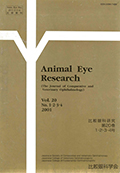Volume 20, Issue 1-2-3-4
Displaying 1-15 of 15 articles from this issue
- |<
- <
- 1
- >
- >|
Original Reports
-
2001Volume 20Issue 1-2-3-4 Pages 1-6
Published: 2001
Released on J-STAGE: December 25, 2020
Download PDF (2846K) -
2001Volume 20Issue 1-2-3-4 Pages 7-10
Published: 2001
Released on J-STAGE: December 25, 2020
Download PDF (1503K) -
2001Volume 20Issue 1-2-3-4 Pages 11-14
Published: 2001
Released on J-STAGE: December 25, 2020
Download PDF (2111K) -
2001Volume 20Issue 1-2-3-4 Pages 15-19
Published: 2001
Released on J-STAGE: December 25, 2020
Download PDF (2750K) -
2001Volume 20Issue 1-2-3-4 Pages 21-25
Published: 2001
Released on J-STAGE: December 25, 2020
Download PDF (2226K) -
2001Volume 20Issue 1-2-3-4 Pages 27-30
Published: 2001
Released on J-STAGE: December 25, 2020
Download PDF (1377K)
Case Report
-
2001Volume 20Issue 1-2-3-4 Pages 31-33
Published: 2001
Released on J-STAGE: December 25, 2020
Download PDF (1506K)
Proceedings - 2000 Annual Meeting
Educational Lecture
-
2001Volume 20Issue 1-2-3-4 Pages 35-37
Published: 2001
Released on J-STAGE: December 25, 2020
Download PDF (1363K) -
2001Volume 20Issue 1-2-3-4 Pages 39-41
Published: 2001
Released on J-STAGE: December 25, 2020
Download PDF (1823K)
Symposium : Education and Training for Comparative and Veterinary Ophthalmologists
-
2001Volume 20Issue 1-2-3-4 Pages 43
Published: 2001
Released on J-STAGE: December 25, 2020
Download PDF (367K) -
2001Volume 20Issue 1-2-3-4 Pages 45
Published: 2001
Released on J-STAGE: December 25, 2020
Download PDF (440K)
Information and Notice
-
2001Volume 20Issue 1-2-3-4 Pages 47-49
Published: 2001
Released on J-STAGE: December 25, 2020
Download PDF (1089K) -
2001Volume 20Issue 1-2-3-4 Pages 51-52
Published: 2001
Released on J-STAGE: December 25, 2020
Download PDF (1211K) -
2001Volume 20Issue 1-2-3-4 Pages 54
Published: 2001
Released on J-STAGE: December 25, 2020
Download PDF (363K) -
2001Volume 20Issue 1-2-3-4 Pages 55
Published: 2001
Released on J-STAGE: December 25, 2020
Download PDF (264K)
- |<
- <
- 1
- >
- >|
